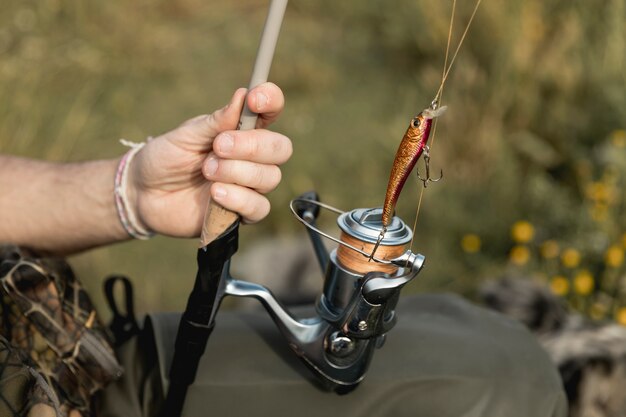Quick Ways to Fix a Broken Fishing Rod
Introduction
There’s nothing quite like the frustration of a broken fishing rod. Whether it snapped mid-cast or during a tough fight with a big fish, a damaged rod can ruin a day on the water. But don’t worry! With the right approach, you can repair most broken rods yourself, saving both money and the sentimental value of your favorite rod. In this guide, we’ll show you how to fix a broken fishing rod (millä liittää katkennut virvelin vapa) using simple materials and easy-to-follow steps.
Why Fishing Rods Break and What You’ll Need to Repair Them
Fishing rods can break for several reasons, including high tension, improper handling, or wear and tear from frequent use. While some breaks might look severe, many rods can be repaired effectively if you have the right materials on hand.
Essential Materials:
- Epoxy Glue or Strong Adhesive – Bonds broken parts securely.
- Fiberglass Tape or Cloth – Reinforces the repair for durability.
- Sandpaper – Smooths out edges for a better bond.
- Heat Shrink Tubing – Protects and reinforces smaller breaks.
- Rod Wraps or Tape – Adds extra stability around the repair area.
Types of Breaks and How to Repair Each One
1. Clean Break in the Middle of the Rod
A clean break in the middle is one of the simplest types to repair, as the two ends can fit back together cleanly.
Steps to Fix:
- Sand the Edges – Use sandpaper to smooth out both broken ends.
- Apply Epoxy – Coat both ends of the break with epoxy glue, spreading it evenly.
- Reinforce with Fiberglass Tape – Wrap fiberglass tape or cloth around the break area, securing it with more epoxy if needed.
- Let it Cure – Allow the epoxy to set for at least 24 hours.
2. Splintered Break Near the Tip
When the break is close to the tip, the repair requires careful handling to maintain flexibility.
Steps to Fix:
- Trim and Sand Splinters – Carefully sand down splintered fibers around the break.
- Apply Epoxy and Tubing – Coat the break area lightly with epoxy and slide a piece of heat shrink tubing over it.
- Heat the Tubing – Use gentle heat to shrink the tubing, creating a tight seal around the repair.
- Wait to Cure – Allow time for the epoxy to fully set before using the rod.
3. Break at the Base of the Rod
Breaks near the base experience more tension, so additional reinforcement is often needed.
Steps to Fix:
- Use an Insert Dowel – Insert a small dowel to add internal support.
- Apply Epoxy and Wrap – Spread epoxy over the break, insert the dowel, and wrap with fiberglass tape for added strength.
- Cure Fully – Give the rod plenty of time to dry and strengthen before testing it out.
Tips for Making Your Fishing Rod Repair Stronger
- Double Wrapping – Adding a second layer of fiberglass or cloth over the break area provides extra strength.
- Testing the Repair Carefully – Before taking it out on the water, test your rod with gentle pressure to check for stability.
- Avoid Overloading the Rod – Even if repaired, try to avoid excessive strain to prolong the rod’s life.
Preventing Future Breaks
Preventing rod breaks in the first place can save you time and money. Here are some quick tips to keep your fishing rod safe:
- Store Carefully: Always store your rod in a protective case to avoid accidental damage.
- Avoid Over-Loading: Be mindful of the rod’s weight limit to avoid putting too much strain on it.
- Use a Rod Sleeve: Using a protective sleeve when transporting or storing your rod can reduce wear and tear.
Conclusion
With a bit of patience and the right materials, you can repair your broken fishing rod (millä liittää katkennut virvelin vapa) and get back to fishing in no time. These DIY fixes will help restore both the look and function of your rod, allowing you to keep enjoying your fishing adventures without the need for an expensive replacement. So, grab your tools, follow these steps, and you’ll be ready to cast again soon!
FAQs
1. Can any fishing rod be repaired after it breaks?
Most rods can be repaired, but some extreme breaks may affect the rod’s performance. Clean breaks are the easiest to fix.
2. Is it safe to use a repaired rod for big fish?
Repaired rods work best for lighter catches. Test the rod first to ensure it can handle weight without further damage.
3. How long does it take for epoxy glue to cure?
Epoxy typically takes 24 hours to fully cure. Always follow the manufacturer’s instructions for best results.
4. What’s the best glue for fishing rod repair?
Epoxy glue is preferred due to its strong, flexible hold once dried.
5. Should I wrap the break multiple times with fiberglass?
Yes, double wrapping can add strength, especially for breaks in high-stress areas like the base.
6. Can I use any dowel for reinforcing the rod base?
It’s best to use a dowel that fits snugly to maintain strength and avoid slipping.

